TUVALU VAITUPU LEADERS OF THE WORLD AUTOMOBILES AND TRAINS STAMP ISSUES AND VARIETIES
The Cars and Trains Stamp Issues for Vaitupu Produced by the Format International Security Printers
A Specialized Study of the Varieties and Quantities Produced
Would YOU store YOUR specialized stamps this way?
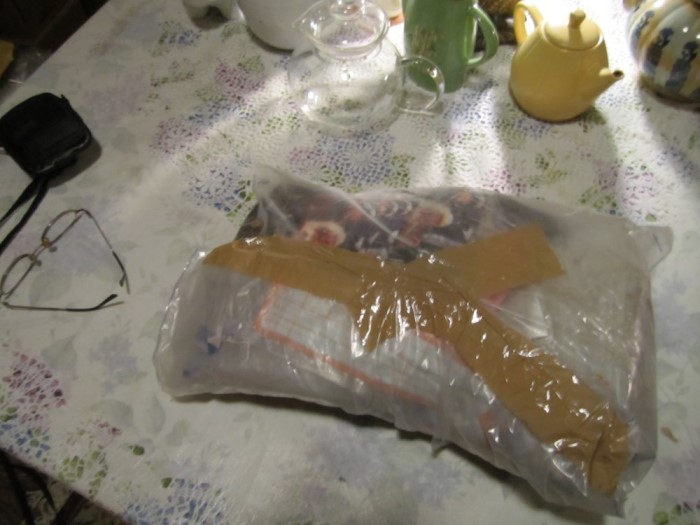

In 1984 Tuvalu and the islands joined other commonwealth countries in the production and issuance of the Leaders of the World (LOW) Automobile and Locomotive series of stamps.
Between 1984 and 1987 Vaitupu issued 3 sets of the Automobile series and 3 sets of the Locomotives series. This page will try to clarify how many sets were issued
and produced and what varieties were also produced. We will show examples of the varieties including progressive color proofs, SPECIMEN overprinted varieties,
Imperforates and yes the made for collector errors and where possible, genuine errors.
There was a huge controversy on the legitimacy of the production and sale of the varieties which ended up in court trials against the owners of the
Format International Security Printers Ltd. and associated companies, their owners and some employees. The trials proved that the companies and owners had
the sole right to reprint, and produce the varieties at their discretion for promotional programs and such despite the objections of the Tuvalu Philatelic Agency and others.
A large portion of the progressives and other varieties were seized as evidence for the trials by the British Metropolitan Police and held by the same until 2008
when they were finally released back to the original owners. See the above image as an example of the cruel way the material was stored. We are lucky it survived!
Representatives for Tuvalu went through the material and confiscated some for destruction but much was left and now these varieties are available to the collecting community
to add to their topical and specialized collections. As for the material from St. Vincent, St. Lucia etc;, it was released back without tampering.
The valuation of the material has been grossly under valued because of the stigma produced by a few agencies, clubs and ex-employees and some dealers over the
past 20+ years instilling in the collecting community the idea that there are "millions" out there hidden away in warehouses, attics etc. This is not
the case and with the evidence I now have, I can now show this to be a huge exaggeration on the facts.
I will present each set as it was issued and show examples of some of the varieties. Either I have exact documents proving what was produced or I will use
existing documentation which shows the general practices used for ordering and printing of the varieties which shows the general consensus of quantities
produced and if possible...what still exists. As (and if) more information and documents are discovered, it will be added to this study for reference to
collectors.
Through evaluation of the documents I have in my possession and the common practices of the printer All sets of LOW Cars and Trains fall
under the same consensus of quantities produced. We know that all issues for Tuvalu and all the islands before 1987 were reprinted once. The standard
was the same for all that 21,000 normal sets were reprinted for the PDC. General invoices and documents show that original orders for many stamp
sets outside the Leaders of the World Series and including the LOW series as well ranged from 15,000 to 25,000 sets for Tuvalu. At that time the PDC had a set
allotment printed for resale via outside stamp selling entities. The allotment was generally 2/3 of the given original orders. The calculation of 21,000
for Tuvalu and the islands appears over and over and is an easy quantity to break down for the allotment. 21,000 went to the Tuvalu Philatelic Bureau and
14,000 went to the PDC's outlets. So I will base on the high figure that a total of 56,000 sets were produced for all the issues except sets printed
in 1987 which documents show a difference. The last sets for some of the countries were never reprinted.
At the time of original printing some Progressive color Proofs and varieties were produced. These were usually in what I call 5-stage or 6-stage
sets. The 5-stage sets include the yellow and black colors combined stage. The 6-stage sets have no all colors with no inscriptions stage.
The 7-stage sets are the reprints for all the series up until late 1986 when the 7-stage sets became the norm. All presentation folders have the reprints.
The reasons for the reprinting were that the earlier printings were from press sheets of which very few were saved. The reprinting was done to produce
limited quantities of varieties for collectors to buy at affordable prices to enhance their collections. The majority of reprints come from cut panes.
Storage of press sheets, which are very large, proved to be from the earlier versions not viable and so almost all the reprints were cut into panes for
ease of storage.
The standard printing was set for all reprints.
3,000 sets of 7-stage progressive color proofs.
5,000 sets of imperforate stamps.
2,000 sets of specimen overprinted stamps
In most cases 1,000 sets of imperforate specimen overprinted stamps and 3,000 sets of misperfed or missing color "errors" were also produced.
Of them, most now appear to have been destroyed.
Most all specimen overprinted stamps, imperforate stamps and errors were all printed at the time of reprinting as allowed by
the "reprint agreement". Therefore all of them have finite numbers. With Tuvalu it was agreed to allow them to confiscate what they deemed as errors. Progressive
color proofs are not errors but they confiscated many and destroyed them before they could be saved. Most all imperforate specimen overprinted sets and quite
a few imperforates and even some of the normal specimen overprinted sets were also taken. I do not know why they did not take all of them but theorize that
because the evidence taken was so large, I am talking about many thousands of panes, that they just simply missed them. The evidence was just thrown into police
evidence bags with no regard to the philatelic preservation what so ever! Thus sorting through the material was quite difficult. Again view the example shown at
the top of the page. Try sorting through several hundred of those!
I have created a special page with links to pages showing examples of the various progressive color proofs used to create the stamps.
The pages will show you closeup images of specific values from the different series to help collectors
define which proof belongs to which series and value.
View the SPECIALIZED Vaitupu Leaders of the World Automobiles and Locomotives Progressive Color Proofs Page here.
LET'S GET STARTED!
1st Series Automobiles issued March 19, 1984

56,000 sets of normal perforated issues were produced.
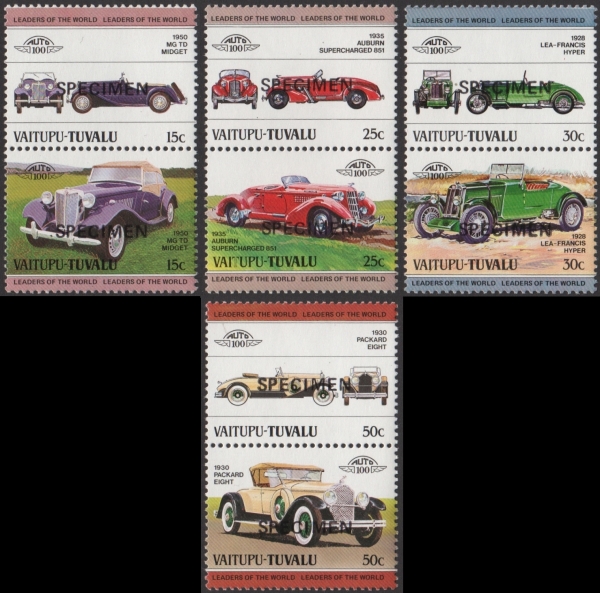
2,000 specimen overprinted sets produced according to general reprinting practices. No imperforate specimen overprinted sets seen on the market
At present there is no evidence that any other varieties exist for the 1st Automobiles series.
It is possible that they were produced but the Tuvalu Philatelic Bureau's representatives may have confiscated and destroyed them.
At this time no imperforates, progressive color proofs nor errors are available on the market.
2nd Series Automobiles issued December 12, 1984

56,000 sets of normal perforated issues were produced.
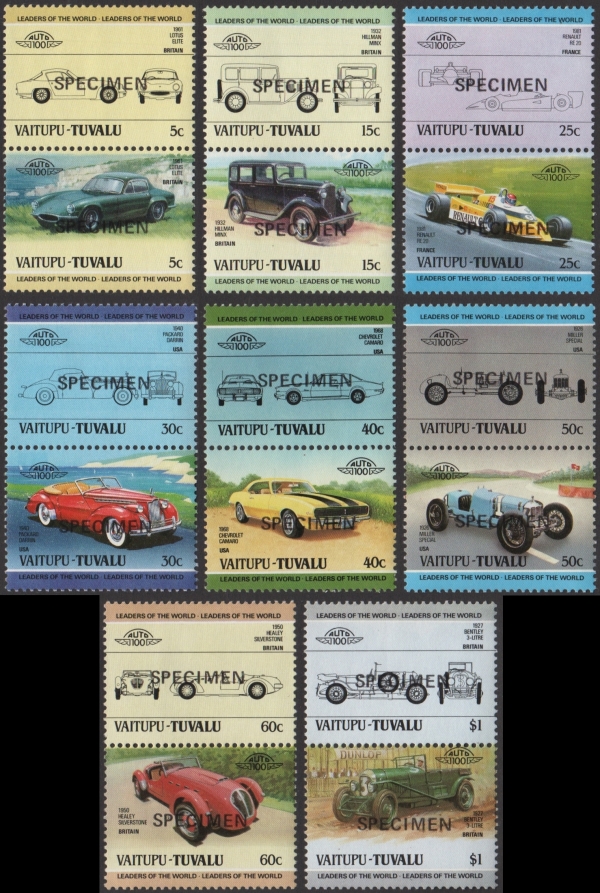
2,000 specimen overprinted sets produced according to general reprinting practices. No imperforate specimen overprinted sets seen on the market
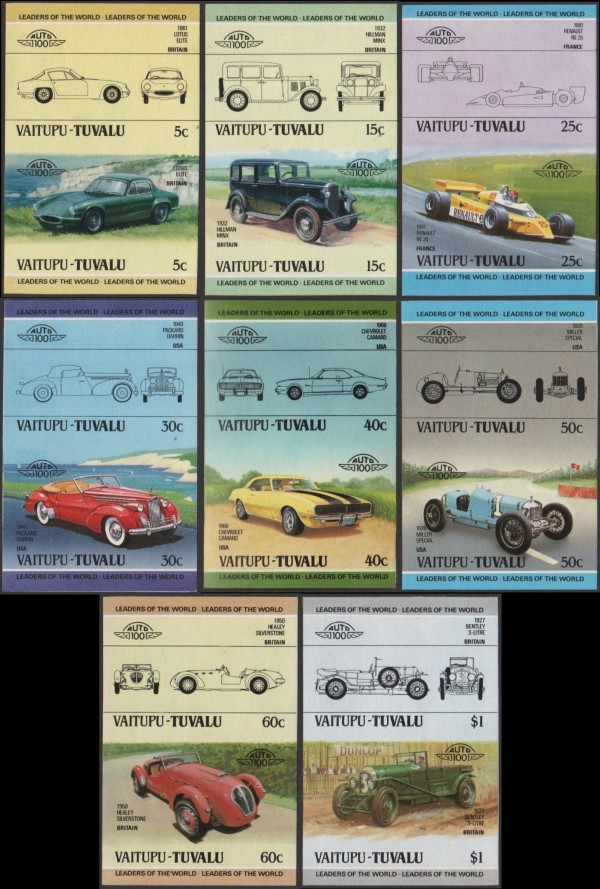
5,000 imperforate sets produced according to general reprinting practices. These were probably missed by the representatives for the Tuvalu Philatelic Bureau.
They were in packets of 100 panes. Probably mixed in the packets of normal perforated panes.
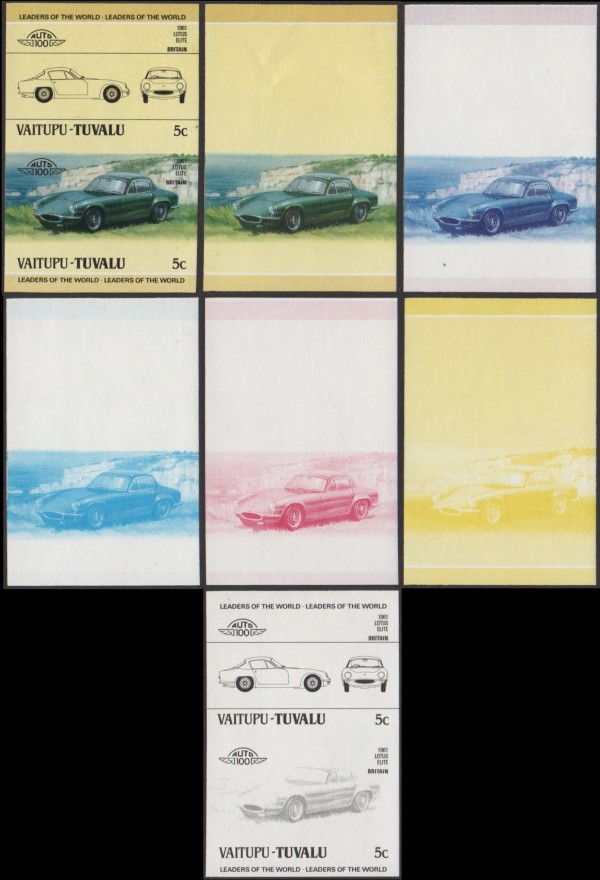
3,000 progressive color proof sets produced according to general printing practices. These are exceedingly rare!
The majority as such apparently destroyed or lost. A Car enthusiast would give their eye teeth for these!
At present there is no evidence that any other varieties exist for the 2nd Automobiles series.
It is possible that they were produced but the Tuvalu Philatelic Bureau's representatives may have confiscated and destroyed them.
At this time, no errors are available on the market and finding the color proofs is virtually impossible!
1st Series Railway Locomotives issued March 7, 1985

56,000 sets of the normal perforated issues were produced.
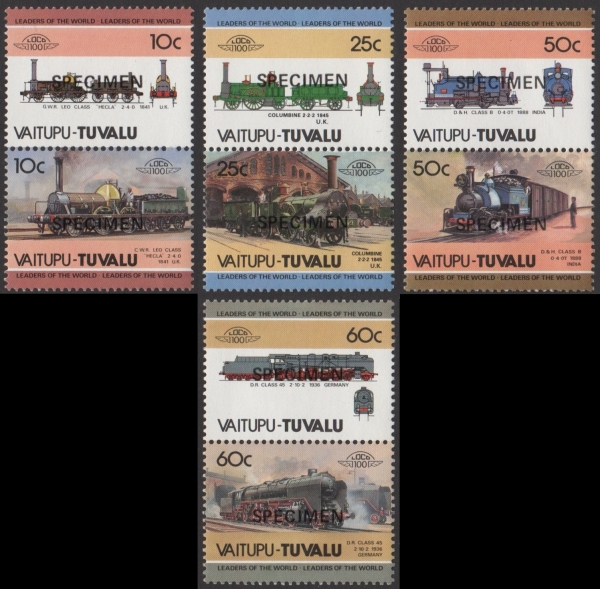
2,000 specimen overprinted sets produced according to general reprinting practices. No imperforate specimen overprinted sets seen on the market

5,000 imperforate sets produced according to general reprinting practices. At present it appears these are rarely offered and difficult to find.
What still exists were probably missed by the representatives for the Tuvalu Philatelic Bureau.
They were in packets of 100 panes. Probably mixed in the packets of normal perforated panes.
I created this image from the final color proof sets.
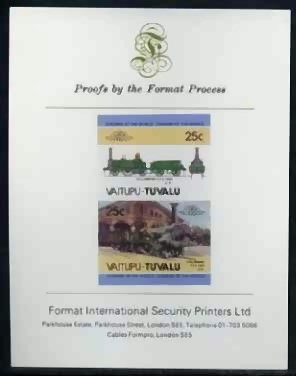
I found that the imperforate 25c is also available on presentation cards showing that they exist.
At present only the one value on card (not in folders) is known available. This puts these in the extremely rare category.
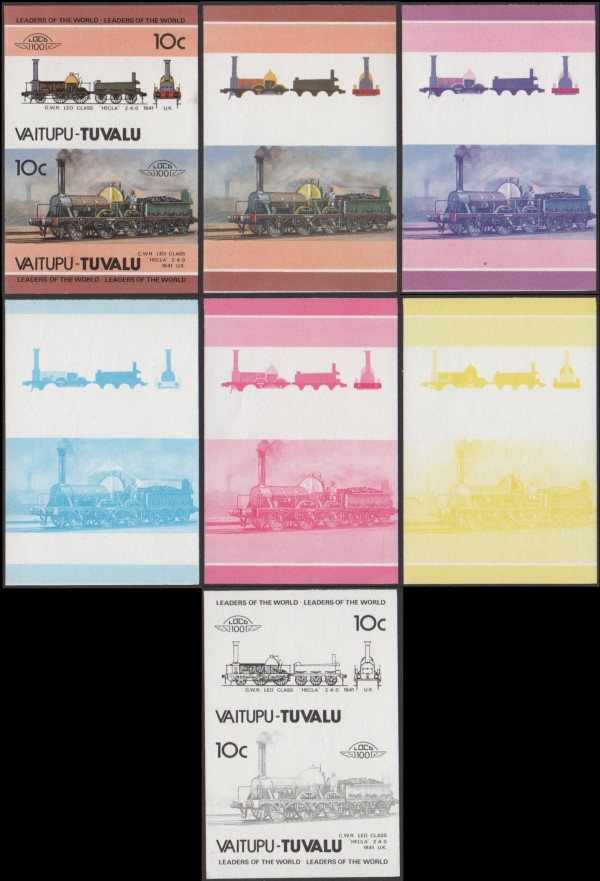
3,000 progressive color proof sets produced according to general printing practices. These are exceedingly rare!
The majority as such apparently destroyed or lost. A Train enthusiast would give their eye teeth for these.
At present there is no evidence that any other varieties exist for the 1st series Locomotives series.
It is probable that they were produced but the Tuvalu Philatelic Bureau's representatives may have confiscated and destroyed them.
At this time, no errors are available on the market and just try to find the color proof stamps!
3rd Series Automobiles issued April 4, 1985

56,000 sets of normal perforated issues were produced.
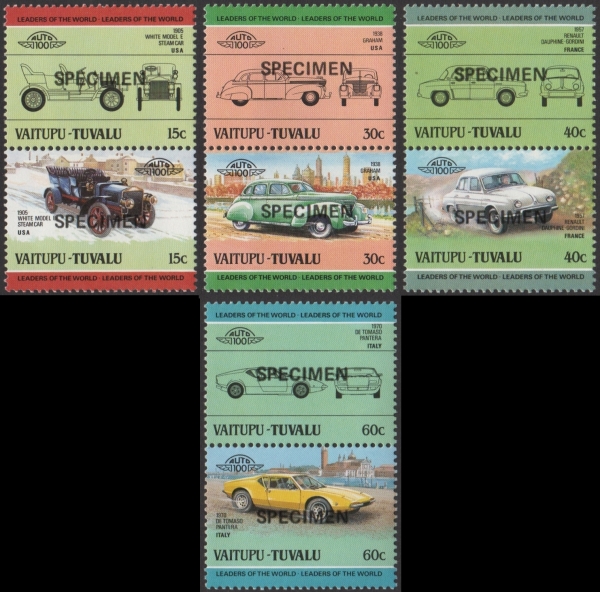
2,000 specimen overprinted sets produced according to general reprinting practices. No imperforate specimen overprinted sets seen on the market
These appear to be exceptionally hard to find. It is possible many were destroyed.
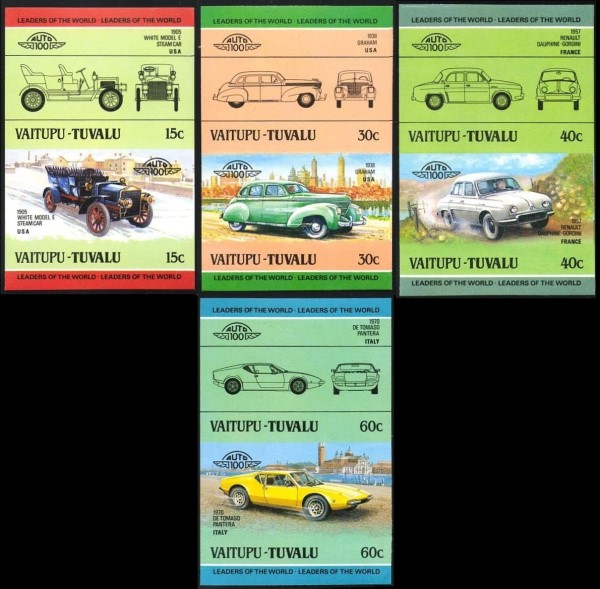
5,000 imperforate sets produced according to general reprinting practices. These were probably missed by the representatives for the Tuvalu Philatelic Bureau.
They were in packets of 100 panes. Probably mixed in the packets of normal perforated panes.
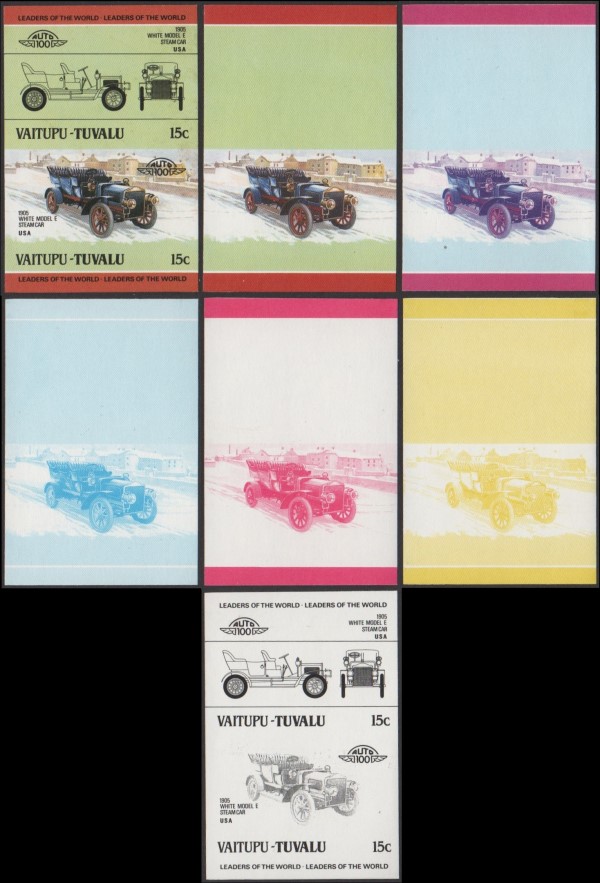
3,000 progressive color proof sets produced according to general printing practices. These are exceedingly rare!
The majority as such apparently destroyed or lost. A Car enthusiast would give their eye teeth for these!
At present there is no evidence that any other varieties exist for the 3rd Automobiles series.
It is possible that they were produced but the Tuvalu Philatelic Bureau's representatives may have confiscated and destroyed them.
At this time, no errors are available on the market. Again just try to find the color proofs!
2nd Series Railway Locomotives issued January 16, 1986
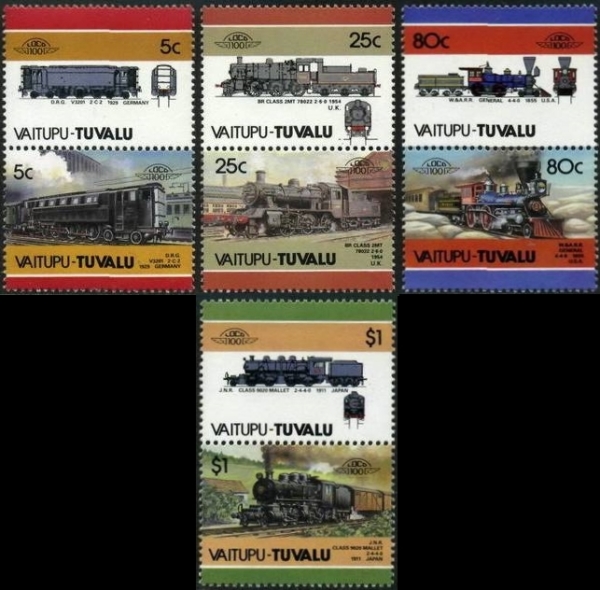
56,000 sets of the normal perforated issues were produced.
IMAGE COMING SOON
2,000 specimen overprinted sets produced according to general reprinting practices. No imperforate specimen overprinted sets seen on the market

5,000 imperforate sets produced according to general reprinting practices. These were probably missed by the representatives for the Tuvalu Philatelic Bureau.
They were in packets of 100 panes. Probably mixed in the packets of normal perforated panes.
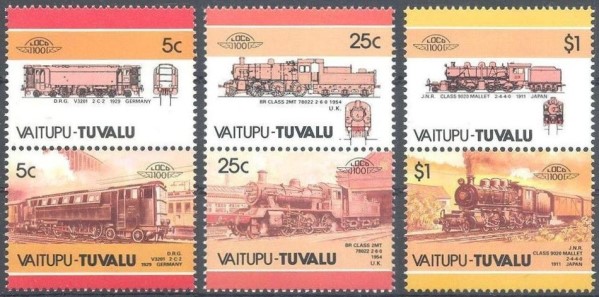
The number of the perforated missing blue error pairs that exist is unknown. It is probable that the 80c value exists this way also but at present none can be found.
Printing practices would make the production at 3,000 perforated pairs of which I found these for sale on the market. No imperforate versions have been seen.
This is a made for collector error.
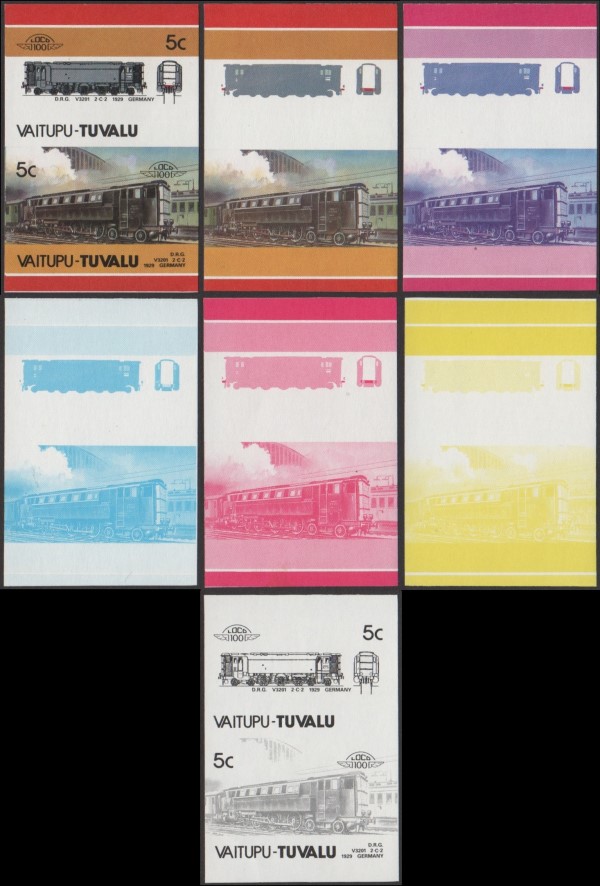
3,000 progressive color proof sets produced according to general printing practices. These are exceedingly rare!
The majority as such apparently destroyed or lost. A Train enthusiast would give their eye teeth for these.
At present there is no evidence that any other varieties exist for the 2nd series Locomotives series.
It is possible that they were produced but the Tuvalu Philatelic Bureau's representatives may have confiscated and destroyed them.
3rd Series Railway Locomotives issued September 10, 1987
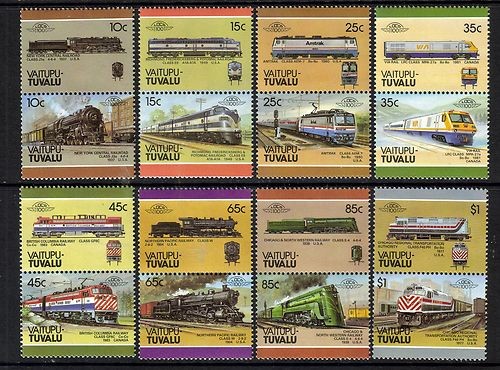
21,000 sets of the normal perforated issues were produced according to the original printing invoice.

2,000 specimen overprinted sets produced according to original printing invoice.

I found this partial set of imperforate specimen overprinted stamps on the market. At present it is unknown if the other values still exist.
1,000 sets produced according to the original printing invoice.
At present there is no evidence that any other varieties exist for the 3rd series Locomotives series.
It is probable that they were produced but the Tuvalu Philatelic Bureau's representatives may have confiscated and destroyed them.
At this time, no imperforates (other than some of the specimen overprinted ones), errors nor progressive color proofs are available on the market.
This concludes our study of the varieties produced for the Leaders of the World Automobiles and Locomotives series issued by Vaitupu.
I hope that this clarifies the point that the stigma that millions were made of each issue is completely false and should be ignored
by collectors and dealers of these issues. Because of a few biased and exaggerated opinions and written articles on these issues of
which they have no evidence to back their claims the LOW stamp issues and varieties have been under valued and shunned by many for years.
Sometimes the "experts" are not such experts as they have not completed the research needed to verify their claims.
I have and this is for you.
Your friend and fellow collector and researcher,
JLowe
References taken from:
Stanley Gibbons Western Pacific
Scott Catalog
Inventory list for the Format Archive by Robson Lowe
Documents obtained from the trial exhibits
Actual materials from the police evidence used in the trials
Online research
Documents obtained from the printers files that still exist
 RETURN TO TOP
RETURN TO TOP
All Content Copyright © 2012 Golowe's Collector Stamps, All Rights Reserved
 Click here to return to last page viewed
Click here to return to last page viewed
Return to Format International Security Printers Reference Home page Here.
Collector stamps are fun!UPDATED LAST ON: 24-Jan-2015 04:03 PM

